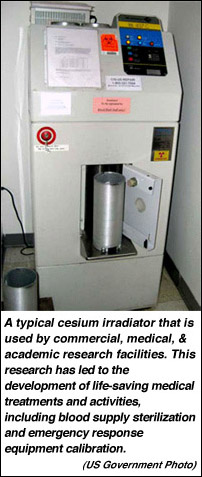Ensuring that radioactive materials from commercial, medical, and academic research facilities do not fall into the hands of individuals or groups that seek to harm the United States is the goal of a public-private partnership initiative between the Department of Homeland Security (DHS), the Department of Energy (DOE), the Nuclear Regulatory Commission (NRC) and irradiator manufacturers.
“The irradiator program is an excellent example of the federal government working with our partners in industry to enhance the protection and resiliency of the Nuclear Sector to ensure the health and safety of the public as well as the environment,” Craig Conklin, director of the Sector-Specific Agency Executive Management Office (SSA-EMO) in the DHS Office of Infrastructure Protection said. The SSA-EMO provides the coordination for the Nuclear Sector under the National Infrastructure Protection Plan. [See http://www.dhs.gov/xlibrary/assets/NIPP_Plan.pdf for additional information].
Under the program, the DOE National Nuclear Security Administration (NNSA) Global Threat Reduction Initiative (GTRI) coordinates with irradiator operators to enable manufacturer-licensed service providers to install hardware improvements retrofitted to existing irradiators onsite. “The security enhancements include adding devices which significantly increase the amount of time need for the unauthorized removal of radioactive material,” Conklin said. Offered at no cost to facility operators, GTRI is funding both the equipment and installation of these security enhancements, which represents a national investment of approximately $26 million.
”We anticipate that these improvements will be incorporated into most of the self-contained irradiators located at universities, hospitals, and research institutes in the United States by fiscal year 2016,” Conklin added that “Once complete, this cooperative effort will greatly reduce the potential for theft or misuse of radiological materials for the purpose of building a Radiological Dispersal Device or dirty bomb.”
The GTRI provides voluntary security enhancements to the Nation’s civilian radiological sites. These voluntary upgrades enhance existing national security programs required by the NRC and State governments since 2006.
Three private sector irradiator manufacturers are involved in the program. In addition to assisting in developing and installing the hardware improvements, these manufacturers also agreed to install security enhancements on all new cesium-137 chloride (CsCl) irradiators that they produce by early 2010, ensuring new irradiators are better protected as they come off the production line.
“Every day, cesium irradiators are used in labs across the country and around the world for critically important and cutting edge academic and medical research,” Conklin said. “This research, which has been conducted in the U.S. for decades, has led to the development of life-saving medical treatments and activities, including blood supply sterilization and emergency response equipment calibration.”
Conklin said the effort is focused on CsCI because “Federal studies indicate that cesium chloride may be a greater concern than other radiation sources that may be used for nefarious purposes because of its dispersability potential.”
The NRC, the Federal agency responsible for assuring that these devices and sources are protected, has stated security controls implemented during the past eight years have significantly improved the security of radioactive sources, including CsCl.
In an ongoing effort to stay ahead of the ever-evolving threats, DHS, DOE, and the NRC continue to work with Federal, State, local and international partners to enhance security protocols, explore new ways to better secure these materials and devices, and guide research efforts in this area.
The University of Pennsylvania is working with the NNSA at DOE and the device manufacturers as the pilot facility for enhancing the security of irradiators around the country. “The University of Pennsylvania has a long history of partnerships with the public and private sectors and we are happy to be the pilot facility for this important program,” Robert D. Forrest, director of Radiation Safety at the University of Pennsylvania said.
The program is just one part of a larger voluntary security enhancement effort funded by GTRI to reinforce detection and response capabilities at civilian nuclear and radiological facilities.
__________________
DHS is designated as the Sector Specific Agency (SSA) for the Nuclear Sector. The SSA Executive Management Office in the DHS Office of Infrastructure Protection provides the coordination for the Nuclear Sector in accordance with the National Infrastructure Protection Plan.
